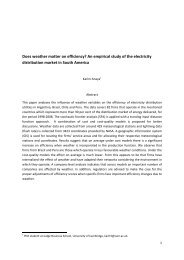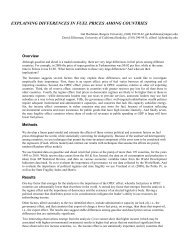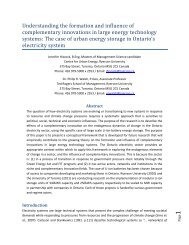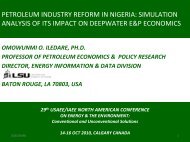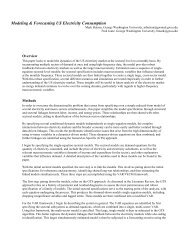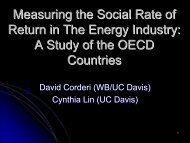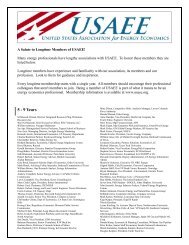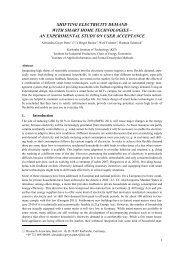GIS-Integrated Agent-Based Model of Residential Solar PV Diffusion
GIS-Integrated Agent-Based Model of Residential Solar PV Diffusion
GIS-Integrated Agent-Based Model of Residential Solar PV Diffusion
- No tags were found...
Create successful ePaper yourself
Turn your PDF publications into a flip-book with our unique Google optimized e-Paper software.
however, the median home value <strong>of</strong> adopters has decreased from $391,00 to $371,000 from 2008 to 2012.Logistic regression was used to calculate the odds <strong>of</strong> a household adopting solar <strong>PV</strong> in Austin accordingto equation 6, where n is the number <strong>of</strong> households, Nei is the number <strong>of</strong> adopters within 1500ft, gis the home value decile, and HV C is a binary variable for each home value decile g. Empirically, wefind that the odds <strong>of</strong> adoption depend significantly on market value deciles , with higher odds for highermarket value deciles (results not shown here). This information is used to initialize the opinion thresholdfor agents depending on their wealth–thus, the opinion threshold <strong>of</strong> a household in the highest homevalue decile (> $510k) has an opinion threshold roughly 5 times higher than an equivalent household isthe 5 th home value decile ($166k-$193k). In future work, we will explore other model constructs thatemploy this empirical observation (odds <strong>of</strong> adoption depending on home value/wealth) more directly,for example by using it to initialize the payback thresholds.Adopt i =1 + e −(β0+ n ∑1∑( 10β gHV C g) i+β 2Nei i)i=1 g=1(6)2.7 <strong>Model</strong> EvaluationEach batch <strong>of</strong> the ABM was evaluated against empirical data in two ways: over time through deviation(RMSE) in marginal quarterly and cumulative quarterly adoption, and over space through spatial autocorrelationmapping <strong>of</strong> adopters. <strong>Model</strong>s were said to perform better with lower RMSE, and a largernumber <strong>of</strong> matching spatial hot-spots.2.7.1 Root Mean Squared ErrorResiduals for the marginal number <strong>of</strong> new adopters and the cumulative number <strong>of</strong> adopters were calculatedby subtracting the model output for a given quarter from the empirical outcome in the samequarter. The deviation, or root mean squared error (RMSE) <strong>of</strong> the model was calculated accordingly,where q is a given quarter, â is the number <strong>of</strong> adopters in the model, and a is the number <strong>of</strong> adoptersin the empirical data:n∑RMSE = √ ( (â − a q) 2) (7)nq=1We assume that models with lower deviation more accurately represent the reality <strong>of</strong> aggregate consumerdecision-making processes.2.8 Hot-Spot AnalysisWe evaluated areas within the study area that empirically displayed clustering <strong>of</strong> <strong>PV</strong> adopters comparedto where these clusters were predicted by the ABM. To do this we divided the study area into 4000ftx 4000ft cells, and performed hot-spot analysis using the Getis-Ord G ∗ i test statistic to generate localestimates for significant spatial autocorrelation along 2000ft distance bands, where w ij is the spatialweight between cell i and cell j, x j is the number <strong>of</strong> adopters in that cell, ¯X is the mean number <strong>of</strong>8



